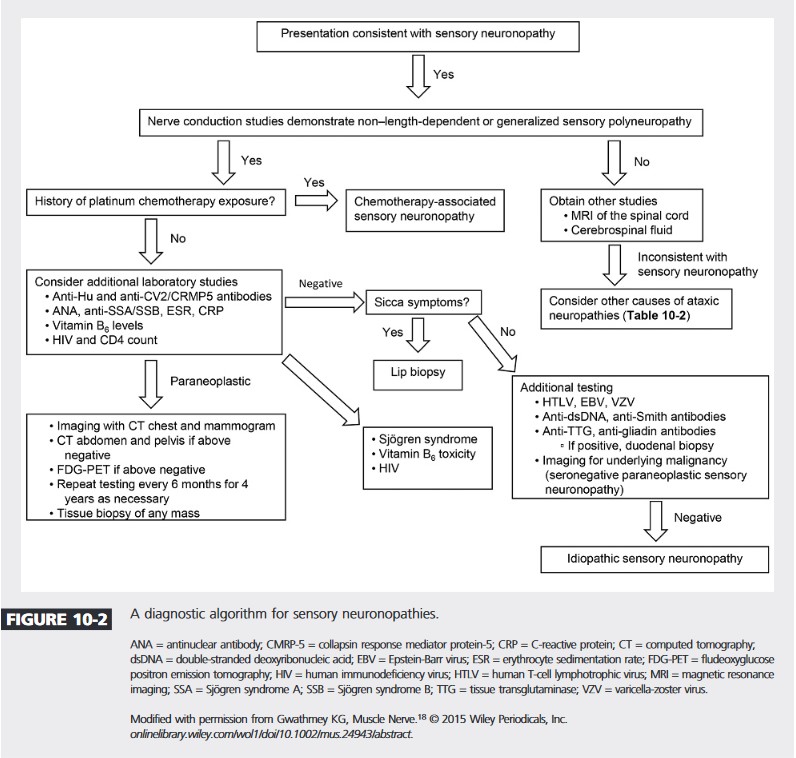Neuronopathies: Difference between revisions
(Created page with "Neuronopathy means the cell body is affected rather than the myelin or axon as in peripheral neuropathy. This article is focused on the sensory neuronopathies. == Classification == The classification of neuropathic disorders is as follows * Neuronopathies (pure sensory or pure motor or autonomic) ** Sensory neuronopathies (ganglionopathies) ** Motor neuronopathies (motor neuron disease) ** Autonomic neuropathies * Peripheral neuropathies (usually sensorimotor) ** Myeli...") |
No edit summary |
||
| Line 1: | Line 1: | ||
Neuronopathy means the cell body is affected rather than the myelin or axon as in peripheral neuropathy. This article is focused on the sensory neuronopathies. | Neuronopathy means the cell body is affected rather than the myelin or axon as in peripheral neuropathy. This article is focused on the sensory neuronopathies where there is primary degeneration of the dorsal root ganglion and trigeminal ganglion sensory neurons. | ||
== Classification == | == Classification == | ||
| Line 15: | Line 15: | ||
== Clinical Features == | == Clinical Features == | ||
The sensory neuronopathies classically present with early onset sensory ataxia, potentially secondary to proximal muscle spindle and joint denervation.<ref name=":0">{{Cite journal|last=Gwathmey|first=Kelly Graham|date=2016-01|title=Sensory neuronopathies|url=https://pubmed.ncbi.nlm.nih.gov/26467754|journal=Muscle & Nerve|volume=53|issue=1|pages=8–19|doi=10.1002/mus.24943|issn=1097-4598|pmid=26467754}}</ref> Note, sensory ataxia can also be caused by large fibre neuropathy and pathology localised to the dorsal column. | |||
If the small and medium sized nerves are also involved then the patient may experience neuropathic pain (positive sensory symptoms). | If the small and medium sized nerves are also involved then the patient may experience neuropathic pain (positive sensory symptoms). | ||
This leads to the other classic feature being that the negative symptoms (numbness) and positive symptoms often present with a non-length-dependent and multifocal pattern. This differentiates them from typical length dependent axonal sensory polyneuropathies. Misdiagnosis can occur if the examiner is testing sensation from distal to proximal and stops at the presumed sensory level, thereby missing the multifocal presentation. | |||
Vestibular dysfunction can occur, such as in CANVAS syndrome. | Vestibular dysfunction can occur, such as in CANVAS syndrome . | ||
[[Motor System Examination|Power]] is usually normal, but patients may appear weak due to lack of proprioceptive feedback. | [[Motor System Examination|Power]] is usually normal, but patients may appear weak due to lack of proprioceptive feedback. | ||
The muscle stretch [[Reflex Testing|reflexes]] are often unelicitable. | The muscle stretch [[Reflex Testing|reflexes]] are often unelicitable. | ||
[[Category: | |||
== Aetiology == | |||
* Immune mediated disease | |||
* Paraneoplastic disease | |||
* Viral infections | |||
* Vitamin B6 | |||
* Intoxication | |||
* Neurotoxic drugs | |||
* Hereditary and degenerative disorders: hereditary sensory autonomic neuropathy (HSAN), Charcot-Marie-tooth disease type 2B (CMT2B), sensory ataxia neuropathy with dysarthria and ophthalmoparesis (SANDO), facial-onset sensory motor neuronopathy (FOSMN), and Cerebellar ataxia, neuropathy, vestibular areflexia syndrome (CANVAS)<ref name=":0" /> | |||
* Idiopathic | |||
== Investigations == | |||
[[File:Sensory neuronopathy algorithm continuum.jpg|center|frame|Diagnostic algorithm from 2016 Continuum article<ref>{{Cite journal|last=Gwathmey|first=Kelly Graham|date=2017-10|title=Sensory Polyneuropathies|url=https://journals.lww.com/00132979-201710000-00016|journal=CONTINUUM: Lifelong Learning in Neurology|language=en|volume=23|issue=5|pages=1411–1436|doi=10.1212/CON.0000000000000518|issn=1538-6899}}</ref>]] | |||
== References == | |||
[[Category:Polyneuropathies]] | |||
Revision as of 19:50, 27 November 2023
Neuronopathy means the cell body is affected rather than the myelin or axon as in peripheral neuropathy. This article is focused on the sensory neuronopathies where there is primary degeneration of the dorsal root ganglion and trigeminal ganglion sensory neurons.
Classification
The classification of neuropathic disorders is as follows
- Neuronopathies (pure sensory or pure motor or autonomic)
- Sensory neuronopathies (ganglionopathies)
- Motor neuronopathies (motor neuron disease)
- Autonomic neuropathies
- Peripheral neuropathies (usually sensorimotor)
- Myelinopathies
- Axonopathies
- Large- and small-fibre
- Small-fibre
Clinical Features
The sensory neuronopathies classically present with early onset sensory ataxia, potentially secondary to proximal muscle spindle and joint denervation.[1] Note, sensory ataxia can also be caused by large fibre neuropathy and pathology localised to the dorsal column.
If the small and medium sized nerves are also involved then the patient may experience neuropathic pain (positive sensory symptoms).
This leads to the other classic feature being that the negative symptoms (numbness) and positive symptoms often present with a non-length-dependent and multifocal pattern. This differentiates them from typical length dependent axonal sensory polyneuropathies. Misdiagnosis can occur if the examiner is testing sensation from distal to proximal and stops at the presumed sensory level, thereby missing the multifocal presentation.
Vestibular dysfunction can occur, such as in CANVAS syndrome .
Power is usually normal, but patients may appear weak due to lack of proprioceptive feedback.
The muscle stretch reflexes are often unelicitable.
Aetiology
- Immune mediated disease
- Paraneoplastic disease
- Viral infections
- Vitamin B6
- Intoxication
- Neurotoxic drugs
- Hereditary and degenerative disorders: hereditary sensory autonomic neuropathy (HSAN), Charcot-Marie-tooth disease type 2B (CMT2B), sensory ataxia neuropathy with dysarthria and ophthalmoparesis (SANDO), facial-onset sensory motor neuronopathy (FOSMN), and Cerebellar ataxia, neuropathy, vestibular areflexia syndrome (CANVAS)[1]
- Idiopathic
Investigations

References
- ↑ 1.0 1.1 Gwathmey, Kelly Graham (2016-01). "Sensory neuronopathies". Muscle & Nerve. 53 (1): 8–19. doi:10.1002/mus.24943. ISSN 1097-4598. PMID 26467754. Check date values in:
|date=(help) - ↑ Gwathmey, Kelly Graham (2017-10). "Sensory Polyneuropathies". CONTINUUM: Lifelong Learning in Neurology (in English). 23 (5): 1411–1436. doi:10.1212/CON.0000000000000518. ISSN 1538-6899. Check date values in:
|date=(help)

